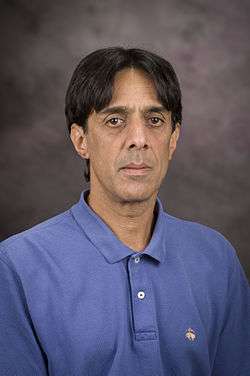Bharat Ratra
| Bharat Vishnu Ratra | |
|---|---|
 | |
| Born |
January 26, 1960 Bombay (Mumbai), India |
| Fields |
Theoretical physics Physical cosmology Astroparticle physics |
| Institutions |
Kansas State University Massachusetts Institute of Technology California Institute of Technology Princeton University Stanford University |
| Alma mater |
Indian Institute of Technology Delhi (MS) Stanford University (PhD) |
| Doctoral advisor |
Leonard Susskind Michael Peskin |
| Known for |
Quintessence (physics) Dark energy |
Bharat Vishnu Ratra (born January 26, 1960) is an Indian-American physicist and theoretical cosmologist and astroparticle physicist who is currently university distinguished professor of physics at Kansas State University.[1]
He is known for his work on dynamical dark energy and on the quantum-mechanical generation of energy density and magnetic field fluctuations during inflation.
Biography
Ratra was born in Bombay (Mumbai). He graduated with a Master of Science in physics from the Indian Institute of Technology Delhi, in 1982, and completed his doctorate in physics at Stanford University in 1986 under the supervision of Leonard Susskind and Michael Peskin.
Ratra was a postdoctoral fellow at the Stanford Linear Accelerator Center, Princeton University, the California Institute of Technology and the Massachusetts Institute of Technology. He joined Kansas State University in 1996 as an assistant professor of physics. He was promoted to associate professor in 2001 and professor in 2004.
Academics and research
Ratra has worked in a number of areas of cosmology and astroparticle and early universe physics.
In 1988, Ratra and Jim Peebles of Princeton University proposed the first dynamical dark energy scalar field, or quintessence, model. Dark energy is the leading candidate for the mechanism that is responsible for causing the observed accelerated cosmological expansion.
Ratra's early universe research includes the first consistent semi-classical computation of the spectrum of energy density perturbations from inflation. He collaborated with Willy Fischler, of the University of Texas at Austin, and Leonard Susskind, of Stanford University, on this computation.
Ratra also proposed the first inflation model that can generate, from quantum fluctuations, a large-enough primordial cosmological magnetic field to be able to explain observed galactic magnetic fields.
Honours
- National Science Foundation CAREER award (1999)
- Fellow of the American Physical Society (2002)
- Fellow of the American Association for the Advancement of Science (2005)
References
- O. Farooq and B. Ratra, "Hubble parameter measurement constraints on the cosmological deceleration-acceleration transition redshift", Astrophys. J. 766, L7 (2013)
- B. Ratra and M. S. Vogeley, "The beginning and evolution of the universe", Pub. Astron. Soc. Pacific 120, 235 (2008)
- P. J. E. Peebles and B. Ratra, "The cosmological constant and dark energy", Rev. Mod. Phys. 75, 559 (2003)
- B. Ratra, "Cosmological `seed' magnetic field from inflation", Astrophys. J. 391, L1 (1992) (PDF)
- B. Ratra and P. J. E. Peebles, "Cosmological consequences of a rolling homogeneous scalar field", Phys. Rev. D 37, 3406 (1988)
- P. J. E. Peebles and B. Ratra, "Cosmology with a time-variable cosmological 'constant'", Astrophys. J. 325, L17 (1988) (PDF)
- W. Fischler, B. Ratra, and L. Susskind, "Quantum mechanics of inflation", Nucl. Phys. B 259, 730 (1985)
Footnotes
- ↑ "Department of Physics". ksu.edu.